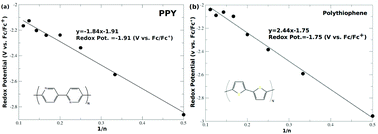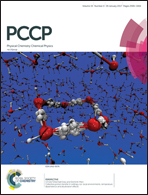Assessing the electrochemical properties of polypyridine and polythiophene for prospective applications in sustainable organic batteries
Abstract
Conducting polymers are being considered promising candidates for sustainable organic batteries mainly due to their fast electron transport properties and high recyclability. In this work, the key properties of polythiophene and polypyridine have been assessed through a combined theoretical and experimental study focusing on such applications. A theoretical protocol has been developed to calculate redox potentials in solution within the framework of the density functional theory and using continuous solvation models. Here, the evolution of the electrochemical properties of solvated oligomers as a function of the length of the chain is analyzed and then the polymer properties are estimated via linear regressions using ordinary least square. The predicted values were verified against our electrochemical experiments. This protocol can now be employed to screen a large database of compounds in order to identify organic electrodes with superior properties.



 Please wait while we load your content...
Please wait while we load your content...